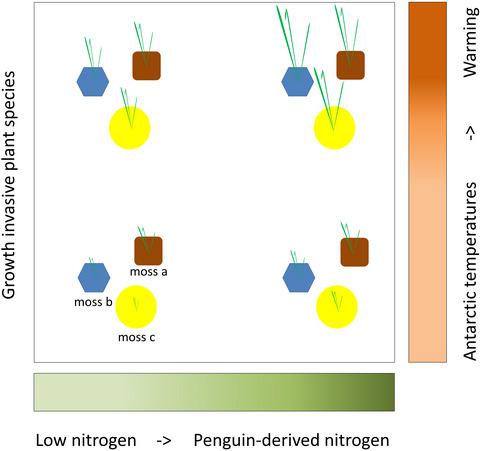当前位置:
X-MOL 学术
›
Glob. Change Biol.
›
论文详情
Our official English website, www.x-mol.net, welcomes your
feedback! (Note: you will need to create a separate account there.)
Temperature impact on the influence of penguin-derived nutrients and mosses on non-native grass in a simulated polar ecosystem
Global Change Biology ( IF 10.8 ) Pub Date : 2021-11-08 , DOI: 10.1111/gcb.15979 Stef Bokhorst 1 , Peter Convey 2, 3 , Richard van Logtestijn 1 , Rien Aerts 1
Global Change Biology ( IF 10.8 ) Pub Date : 2021-11-08 , DOI: 10.1111/gcb.15979 Stef Bokhorst 1 , Peter Convey 2, 3 , Richard van Logtestijn 1 , Rien Aerts 1
Affiliation

|
Human activity and climate change are increasing the spread of species across the planet, threatening biodiversity and ecosystem functions. Invasion engineers, such as birds, facilitate plant growth through manuring of soil, while native vegetation influences plant germination by creating suitable microhabitats which are especially valuable in cold and dry polar regions. Here we tested how penguin-derived nitrogen, several common Antarctic moss species and warming affect seed germination and growth of the non-native grass Agrostis capillaris under laboratory conditions. Experimental settings included a simulation of contemporary season-specific Antarctic light and temperature (2°C) conditions and a +5°C warming scenario. Mosses (Andreaea depressinervis, A. regularis, Sanionia uncinata and Chorisodontium aciphyllum) incorporated a range of nitrogen content and isotopic nitrogen signatures (δ15N) due to variation in sampling proximity to penguin colonies. Moss species greatly affected time to germination with consequences for further growth under the simulated Antarctic conditions. Grass seeds germinated 10 days earlier among A. regularis compared to S. uncinata and C. aciphyllum and 26 days earlier compared to A. depressinervis. Moss-specific effects are likely related to microclimatic differences within the moss canopy. Warming reduced this moss influence. Grass emerged on average 20 days earlier under warming, leading to increased leaf count (88%), plant height (112%) and biomass (145%). Positive correlations were identified between moss and grass nitrogen content (r = 0.377), grass biomass (r = 0.332) and height (r = 0.742) with stronger effects under the warming scenario. Transfer of nitrogen from moss to grass was confirmed by δ15N (r = 0.803). Overall, the results suggest a shift from temperature-limited to N-limited growth of invasive plants under increased warming in the maritime Antarctic.
中文翻译:

温度对模拟极地生态系统中企鹅来源的营养物质和苔藓对非本地草的影响的影响
人类活动和气候变化正在增加物种在地球上的分布,威胁到生物多样性和生态系统功能。入侵工程师,如鸟类,通过施肥促进植物生长,而原生植被通过创造合适的微生境来影响植物发芽,这在寒冷和干燥的极地地区特别有价值。在这里,我们在实验室条件下测试了企鹅衍生的氮、几种常见的南极苔藓物种和变暖如何影响非本地草Agrostis capillari s 的种子萌发和生长。实验设置包括模拟当代特定季节的南极光和温度 (2°C) 条件和 +5°C 变暖情景。苔藓 ( Andreaea depressinervis , A.regularis、Sanionia uncinata和Chorisodontium aciphyllum)结合了一系列氮含量和同位素氮特征(δ 15 N),这是由于靠近企鹅群落的采样存在差异。苔藓物种极大地影响了发芽时间,从而在模拟的南极条件下进一步生长。草种子在A中提前 10 天发芽。正则与S相比。uncinata和C . aciphyllum比A早 26 天。抑郁症. 苔藓特有的影响可能与苔藓树冠内的小气候差异有关。变暖减少了这种苔藓的影响。草在变暖的情况下平均提前 20 天出现,导致叶数 (88%)、株高 (112%) 和生物量 (145%) 增加。在变暖情景下,苔藓和草氮含量(r = 0.377)、草生物量(r = 0.332)和高度(r = 0.742)之间存在正相关,具有更强的影响。δ 15 N (r = 0.803)证实了氮从苔藓到草的转移。总体而言,结果表明,在南极海洋变暖加剧的情况下,入侵植物的生长从温度限制转向氮限制生长。
更新日期:2022-01-05
中文翻译:

温度对模拟极地生态系统中企鹅来源的营养物质和苔藓对非本地草的影响的影响
人类活动和气候变化正在增加物种在地球上的分布,威胁到生物多样性和生态系统功能。入侵工程师,如鸟类,通过施肥促进植物生长,而原生植被通过创造合适的微生境来影响植物发芽,这在寒冷和干燥的极地地区特别有价值。在这里,我们在实验室条件下测试了企鹅衍生的氮、几种常见的南极苔藓物种和变暖如何影响非本地草Agrostis capillari s 的种子萌发和生长。实验设置包括模拟当代特定季节的南极光和温度 (2°C) 条件和 +5°C 变暖情景。苔藓 ( Andreaea depressinervis , A.regularis、Sanionia uncinata和Chorisodontium aciphyllum)结合了一系列氮含量和同位素氮特征(δ 15 N),这是由于靠近企鹅群落的采样存在差异。苔藓物种极大地影响了发芽时间,从而在模拟的南极条件下进一步生长。草种子在A中提前 10 天发芽。正则与S相比。uncinata和C . aciphyllum比A早 26 天。抑郁症. 苔藓特有的影响可能与苔藓树冠内的小气候差异有关。变暖减少了这种苔藓的影响。草在变暖的情况下平均提前 20 天出现,导致叶数 (88%)、株高 (112%) 和生物量 (145%) 增加。在变暖情景下,苔藓和草氮含量(r = 0.377)、草生物量(r = 0.332)和高度(r = 0.742)之间存在正相关,具有更强的影响。δ 15 N (r = 0.803)证实了氮从苔藓到草的转移。总体而言,结果表明,在南极海洋变暖加剧的情况下,入侵植物的生长从温度限制转向氮限制生长。











































 京公网安备 11010802027423号
京公网安备 11010802027423号